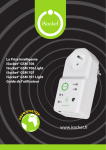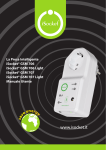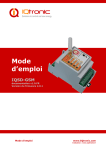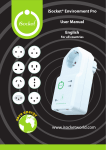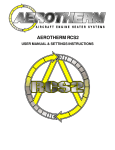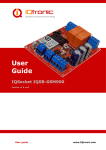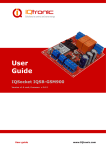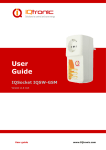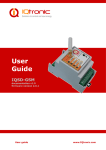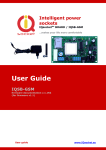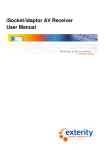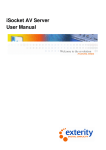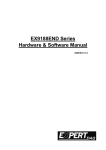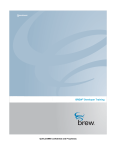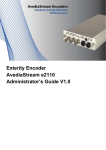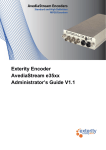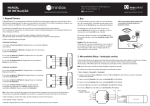Download iSocket GSM 706/707 User Guide (EN)
Transcript
ENGLISH. The colour version of this document can be found on the website www.isocket.eu
Thank you for choosing iSocket. Please take a few minutes to read through these operating
instructions carefully before using it so that you can take full advantage of the functionality and
get maximum enjoyment from it. Pay special attention to the safety instructions in Chapter 2!
Incorrect use could affect your guarantee or jeopardise health or property. We reserve the right
to make design changes on the device and its software without prior notice. Deviations not
mentioned in this instruction might exist in the software, which is considered acceptable and not
considered a defect. The latest version of these instructions can be found on our website
www.isocket.eu. Please register as a user if you wish to receive news from the company
(Chapter 20). Be sure to read the terms of warranty before using the device, so that you do not
to lose your rights under the guarantee as a result of improper operation (Chapter 19). You
agree with the terms of warranty and limitation of liability described in Chapter 19 when you
purchase this product. Please keep these operating instructions in a safe place for easy access
when needed. Intellectronics hope you thoroughly enjoy using your iSocket gadget.
NOTE!
These instructions apply to products iSocket GSM 706, iSocket GSM 707
and iSocket GSM 706 Light, iSocket GSM 707 Light. In some cases the text
clearly indicates which option is not available in the "Light" version of the
product. However please refer to technical information (Chapter 17) for
detailed information about the differences in the devices. The "Light"
model does not display commands associated with optional features. This
documentation and product are subject to change without notice.
The software supplied with this product is the exclusive property of
Intellectronics. As an end-user you are granted a non-exclusive license to
use this software solely in combination with the device on which it is
installed and with which it is supplied. The license is non-transferable and
you do not have the rights to grant sublicenses.
You iSocket device has a unique feature " iSocket® Online 24/7" that gets
the device back online even after a break in the GSM-network. However
the device needs a strong GSM signal in the area - it has an internal
antenna and may not operate efficiently if the signal in your area is weak.
Ensure that you have a strong GSM network before using the device. Do
not put metal or other conductive objects near the device - this may
cause signal loss. This product is designed for home and office use only.
Different types of alerts that iSocket send you (power failure / power
restored / temperature rise /temperature fall / sensor triggered / etc.)
rely on the correct configuration of the mobile phone number for the
alerts. Please follow the instructions in section 7.3 where you will find an
introduction to the command ALERTNUMBER which will enable you to
configure this number.
The "707" model uses a Lithium-ion battery and MUST NOT be used
outside the specified temperature! Please refer to technical information
(Chapter 17) for detailed information about operating conditions and read
the safety instruction (Chapter 2) carefully.
iSocket® GSM 706/707
www.isocket.eu
Content
Content ............................................................................................................ 2
1. Device Description ......................................................................................... 3
2. Safety Instructions ......................................................................................... 6
3. Quick Start .................................................................................................... 8
4. Managing the iSocket Device ........................................................................... 9
4.1 Managing by SMS ...................................................................................... 9
4.2 Managing by Phone Call............................................................................ 10
4.3 Manual Managing..................................................................................... 11
5. Security Settings.......................................................................................... 11
5.1 Security Numbers List Settings .................................................................. 11
5.2 Password Protection ................................................................................. 12
5.3 Renewal of the Configuration Interval ........................................................ 12
6. Command Confirmation ................................................................................ 13
6.1 Confirmation of SMS-commands ................................................................ 13
6.2 Confirmation for Phone Calls ..................................................................... 13
6.3 Incorrect Commands, Later Configuration and Commands From Unauthorised
Users ........................................................................................................... 14
7. Measurement and Control of Temperature ....................................................... 14
7.1 Thermometer .......................................................................................... 15
7.2 Thermostat ............................................................................................. 15
7.3 Temperature Monitoring – Notifications, iSocket Temperature Notifier ............ 16
7.4 Temperature Calibration ........................................................................... 17
8. Date and Time ............................................................................................. 17
9. Room Control by Sensors .............................................................................. 17
9.1 Alarm Function and Microrelay .................................................................. 18
9.2 Sensor Activity Alerts - iSocket® Alarm Notifier ........................................... 18
9.3 Alarm Logs ............................................................................................. 19
9.4 External Sensors Scheme ......................................................................... 20
9.5 Microrelay Scheme .................................................................................. 20
10. Microphone and Room Listening ................................................................... 20
11. Scheduler .................................................................................................. 21
12. Status After Resumption of Power Supply ...................................................... 21
13. Credit Information and Subscription Management (experimental) ..................... 22
14. Version Information .................................................................................... 22
15. Original Factory Settings ............................................................................. 22
16. LED Indicators ........................................................................................... 23
17. Technical Data ........................................................................................... 23
18. Troubleshooting ......................................................................................... 24
19. Limits of Warranty and Liability .................................................................... 26
20. Contacts.................................................................................................... 26
© Copyright Intellectronics 2012
All rights reserved. Version 1.1.1-EN
-2-
English
iSocket® GSM 706/707
www.isocket.eu
1. Device Description
iSocket® intelligent devices are designed for the remote control of electrical equipment.
iSocket® devices can also be used for monitoring premises (security control, temperature
monitoring, etc.) and can provide information about the state of the premises via the
mobile network.
Smart socket iSocket GSM 706/707 is designed for remote switching of electrical
equipment connected to it and has some additional useful features. This smart socket is
controlled remotely by SMS-commands via the GSM network, using a standard mobile
phone.
It is also possible to do some operations by a phone call. SIM-cards from most GSMoperators, including prepaid cards, can be installed in iSocket GSM 706/707.
iSocket GSM 706/707 may also be used as a thermostat thanks to its built-in
thermometer, which turns equipment on and off according to your settings. iSocket GSM
706 can send information about the room temperature to your phone. You can also
connect the various sensors via a special connector. Notification will be sent when it is
triggered. For example, it could be a motion sensor, an “opening doors” sensor, fire
detector, gas leakage and many more. A built-in microphone allows you to hear what is
happening in the room from a remote location. Low-voltage equipment, such as alarms
can be connected additional outputs. NOTE! The features mentioned in this paragraph
are not available in the "Light" versions of the product.
The following additional options for using iSocket GSM 706/707
Remote reboot of a computer or server
Remote climate control in-, and temperature notifications from a summer cottage
Switch on a coffee percolator by SMS, so the coffee will be ready for your arrival
Alert about a break-in at home
Switching on and off of lights and alarms
Radio-guard - remote monitoring of sounds in a room in your absence
Plus much more!
Please note that iSocket GSM 706/707 can only be used indoors.
Note that the facility to remotely monitor sounds in premises may not be used for illegal
purposes! More information about microphone feature is available in Chapter 10.
For more information about the technical characteristics of the iSocket GSM 706/707 see
Chapter 15 and also visit our website www.isocket.eu.
© Copyright Intellectronics 2012
All rights reserved. Version 1.1.1-EN
-3-
English
iSocket® GSM 706/707
www.isocket.eu
Main power socket: socket for connecting
external electrical equipment, which can be
controlled remotely. (Figure shows socket
type CEE 7/4 "Schuko", models ISGSM706EU,
ISGSM707EU, ISGSML706EU, ISGSML707EU).
POWER
Indicator of input power from power
network.
GSM
Status indicator for GSM network.
MICROPHONE
Indicate when microphone is activated.
OUT
Indicator of output power for main
socket.
Additional information about the
indicators is given in Chapter 16.
Hidden button: used to switch the main
socket manual (Chapter 4.3) or reset
device (Chapter 15).
Built-in microphone (Chapter 10)
(not available in "Light" model)
Input for sensors (Chapter 9)
(not available in "Light" model)
Socket for SIM-card
Microrelay (Chapter 9)
(not available in "Light" model)
Temperature sensor (Chapter 7)
(not available in "Light" model)
Plug to connect iSocket GSM 706/707 to
the wall socket to provide power for device
and for connected appliance. (Figure shows
socket type CEE 7/4, models ISGSM706EU,
ISGSM707EU, ISGSML706EU, ISGSML707EU).
The temperature sensor is located inside the
unit and is connected via a metal barrel to the
outside of the body for more accurate
temperature readings. The temperature sensor
measures temperature and sends it via SMS on
request. The main socket can be controlled by
this sensor in thermostat mode. See Chapter 7.
© Copyright Intellectronics 2012
All rights reserved. Version 1.1.1-EN
-4-
English
iSocket® GSM 706/707
www.isocket.eu
Pictures below describe the plugs and sockets of other models.
Socket/Plug: BS 1363
Model Numbers:
ISGSM706UK
ISGSML706UK
ISGSM707UK
ISGSML707UK
Figure shows model
ISGSM706UK/ISGSM707UK
Please refer to technical
information (Chapter 18)
for more details about the
differences in the two models.
Socket/Plug: NEMA 5-15
Model Numbers:
ISGSM706US
ISGSML706US
ISGSM707US
ISGSML707US
Figure shows model
ISGSM706US/ISGSM707US
Please refer to technical
information (Chapter 18)
for more details about the
differences in the two models.
Socket/Plug: CEE 7/5
(French)
Model Numbers:
ISGSM706FR
ISGSML706FR
ISGSM707FR
ISGSML707FR
Figure shows model
ISGSM706FR/ISGSM707FR
Please refer to technical
information (Chapter 18)
for more details about the
differences in the two models.
© Copyright Intellectronics 2012
All rights reserved. Version 1.1.1-EN
-5-
English
iSocket® GSM 706/707
www.isocket.eu
2. Safety Instructions
This appliance complies with accepted technological standards with regard to safety.
Nevertheless, as manufacturers we consider it our obligation to make you aware of the following
safety information. To ensure years of trouble-free enjoyment, and to maintain your guarantee,
please note the following.
Never carry out repairs yourself! There are no serviceable parts in the device.
The operating voltage of the appliance and the mains voltage as well as the type of
current must match (see the rating plate on the underside of the appliance).
Only plug into a correctly installed earthed mains socket.
The device is not intended for direct plug-in equipment, which are not equipped with a
plug. External equipment that connects to the device must have a cord with appropriate
plug.
Some devices are supplied with their own switch, which needs to be disconnected before
they are unplugged. Do not use this product with such devices - it cannot disable the
switch of a remote device.
Do not use external equipment with a faulty plug!
Do not connect to appliances which cannot be left unattended (e.g. certain heaters)!
Do not exceed power load limit and other electrical parameters specified in the technical
characteristics. Check the power of the connected device!
The device is intended only for domestic private non-commercial use. Do not use in
emergency environments: e.g. military, hospitals etc!
This product is not designed for safe disconnection of the controlled equipment from
power network; the device is not equipped with a residual-current device (RCD). Make
sure that your home electrical network meets safety standards.
The product is designed for indoor use in dry area. Do not use it in wet or chemically
aggressive environments! For example, do not use it in the bathroom. It is also not
designed for industrial operation in aggressive environments.
Do not use this device if the casing is damaged!
Do not shake or drop the product. This could cause damage!
Keep away from direct sunlight.
Keep out of reach of children!
Block access to the management and set-up of the device to unauthorised users
(Chapter 5).
Read additional safety information in Chapter 19.
Intellectronics hereby declares that this Smart GSM Power Socket complies with the essential
requirements and other relevant provisions of Directive 1999/5/EC.
At the end of the product's useful life, please dispose of it at appropriate collection points
provided in your country.
NOTE: This equipment has been tested and found to comply with the limits for a Class B digital
device, pursuant to Part 15 of the FCC Rules. These limits are designed to provide reasonable
protection against harmful interference in a residential installation. This equipment generates,
uses and can radiate radio frequency energy and, if not installed and used in accordance with
the instructions, may cause harmful interference to radio communications. However, there is
no guarantee that interference will not occur in a particular installation. If this equipment does
cause harmful interference to radio or television reception, which can be determined by turning
the equipment off and on, the user is encouraged to try to correct the interference by one or
more of the following measures: reorient or relocate the receiving antenna; increase the
separation between the equipment and receiver; connect the equipment into an outlet on a
circuit different from that to which the receiver is connected; consult the dealer or an
experienced radio/TV technician for help.
© Copyright Intellectronics 2012
All rights reserved. Version 1.1.1-EN
-6-
English
iSocket® GSM 706/707
www.isocket.eu
Safety Instructions for the Battery
The "707" models use a Li-ion battery. The safety instruction doesn't tell you how to
maintain the battery, because this battery is installed inside the unit. It is strict
prohibited to replace the battery yourself - an authorised specialist must be consulted.
However this safety instruction does describe the care of units using a Li-ion battery.
Read all the safety information and instructions. Failure to comply with the
safety information and instructions may cause fire and / or serious injury.
We pay a great deal of attention to the design of every battery to ensure that we supply
you with batteries which offer maximum durability and safety. Despite all the safety
precautions, caution must always be exercised when handling devices with batteries.
Studies have shown that incorrect use and poor care are the main causes of the damage
caused by batteries. The following points must be obeyed at all times to ensure safe
use:
Don't throw battery or device with battery into an open fire. There is a risk of
explosion!
Always comply with the storage conditions (see Chapter 17)! Don't keep the
device with its battery in places where the temperature is liable to reach levels
outside those specified. In particular, do not leave the device in a car that is
parked in the sunshine.
If the battery suffers overloading and/or overheating, the integrated protective
cut-off will switch off the charging/discharging for safety reasons. If this happens
you will not be able to get a power failure alert. Using the battery at temperatures
outside those specified in the technical information (Chapter 17) will cause
chemical damage and may cause a fire.
In the event of incorrect use, fluid may escape from the battery. Avoid contact
with this fluid. If you touch it by mistake, rinse the affected area with water. If
you get the fluid in your eyes, seek medical advice. Stop using the device if fluid is
coming from it!
Li-ion batteries are subject to a natural ageing process. The battery must
absolutely be replaced when its capacity falls just 80% from the capacity as new.
A weakened aged battery is no longer capable of meeting the high power
requirements and therefore poses a safety risk.
Exhaustive discharge will damage the battery. The most common cause of
exhaustive discharge is lengthy storage or non-use of a partly discharged battery.
Don't allow the device to be stored for a long time without use. Never use a
battery-driven device if you suspect that the last time the battery was charged
was more than 12 months ago. There is a high probability that the battery has
already suffered dangerous damage (exhaustive discharge).
Rechargeable batteries contain materials that are potentially harmful to the
environment. Batteries may not be disposed of with normal domestic waste. You
should dispose of used batteries at your local collection point.
© Copyright Intellectronics 2012
All rights reserved. Version 1.1.1-EN
-7-
English
iSocket® GSM 706/707
www.isocket.eu
3. Quick Start
To start work with iSocket GSM 706/707 is very simple. You need a SIM-card from a
GSM-operator. If you have not purchased SIM-card, then do so at the nearest mobile
operator's office. You can also use prepaid cards.
NOTE! You must disable PIN-code authorisation for the SIM-card! The iSocket GSM
706/707 will not work unless you do this. You can only disable PIN authorisation by
using your mobile phone. Do not use SIM-cards that contain messages! Remove all
messages from the SIM-card.
Quick Start comprises three simple steps:
Insert the SIM-card into your mobile phone
and disable PIN usage using the phone menu.
You can find more information in the manual
for your phone or ask assistance from the
shop, where you purchased the mobile
subscription.
1. Turn off PIN authorisation for SIMcard.
2. Insert the SIM-card into the special
slot and push until fixed (you will hear a
click). SIM-card orientation is shown on
the front side of the device.
Do not insert or eject the SIM-card
on a running device! Switch off the
device before you insert or eject
SIM-card.
All indicators blink three times simultaneously
3. Connect the iSocket to a wall socket.
(except GSM indicator). If everything is
functioning the POWER indicator will be green.
If you have forgotten to disable PIN GSM indicator blinks once a second during
authorisation the GSM indicator will network search and every 3 seconds when the
start blinking rapidly. Make sure that network has been found. More information
PIN authorisation was turned off!
about the indicators in Chapter 16.
If the SIM-card is not inserted
The device might reject some old sim cards.
correctly or is damaged the indicator Please make sure you are using a modern sim
POWER and OUT will signal this by
card which complies with specification.
specific blinks (see Chapter 16).
The device is now ready to work! You can carry out a simple test. Connect an appliance
to the iSocket, e.g. a desk lamp (don't forget to turn on the lamp switch). Send the
message ON to the SIM-card number and the lamp will switch on. Send the message
OFF and the lamp will turn off.
© Copyright Intellectronics 2012
All rights reserved. Version 1.1.1-EN
-8-
English
iSocket® GSM 706/707
www.isocket.eu
4. Managing the iSocket Device
You can manage the device with SMS-commands, by phone call or manually. SMS
management offers best performance.
4.1 Managing by SMS
Commands are sent in form of SMS messages to the SIM-card number of the iSocket.
Messages have following syntax:
COMMAND
(for example, STATUS).
If a password was configured (see Chapter 5), then you must use following syntax:
passwordCOMMAND
(for example, 12345STATUS),
where 12345 is a password set by the command PASSWORD=12345 (more details in Chapter 5).
There are three types of commands:
Configuration commands (in the tables these are highlighted in blue and marked "30min")
Allows parameters and functions to configure the iSocket device. The configuration can be performed
only within 30 minutes after device has been powered on or after last configuration command has
been received. If you try to configure device after 30 minutes, then you will get the message
"command – Time for configuration is expired (30min) " (only if ERROR=ON - see Chapter 6). To
remind the user of this limit we have marked configuration commands as "30min" in the column
"type" in the tables. Settings are stored in non-volatile memory and are not lost when power is off.
Information configuration commands (marked "Inf" in the tables)
These commands have a question mark at the end (COMMAND?). These are information commands.
In response you will receive the current value of the parameter, which has the same name as the
command. These commands do not activate the configuration, but only inform you of the value.
These commands are available at any time. You can set up the facility to reset the configuration
interval (see section 5.3).
Control and management commands (marked "Ctrl" in the tables)
Used to control the iSocket device and can be used at any time.
Each command has a default value. This is the value that was installed at the factory
(for details see Chapter 15). Commands are not case sensitive. You will get a response
after sending the command. This can be disabled if desired (see Chapter 6).
Should a configuration command have different values these will all be seen in response
to the information command associated with this configuration command. The values
will be comma-separated and the current active value will be indicated in parentheses.
For example, you send the information command "COMMAND?". In response you will get
the reply "COMMAND=OFF,(ON)". This means that the current active value is "ON", and
"OFF" is another value acceptable for this command. This syntax is made for your
convenience - you do not need to refer to the manual each time when to remember all
possible values. They will be given in the response. The first value in the response is the
factory default value (see Chapter 15).
If you make a mistake in the command and send an incorrect command, you will receive
a message "command - Error!" (Only if ERROR=ON - see Chapter 6). If a command
longer than 30 characters was sent, it will be deleted without any response notifications.
NOTE! Configuration commands are only accepted during the first 30 minutes after
powering on. This is for security reasons. If you want to reconfigure the device, you
must disconnect it from the mains outlet and turn it on again. You can also set up the
facility to reset the configuration interval (see section 5.3).
© Copyright Intellectronics 2012
All rights reserved. Version 1.1.1-EN
-9-
English
iSocket® GSM 706/707
www.isocket.eu
The list of simple commands for management and configuration is shown in the following
table. The real response may differ from those indicated in the table, depending on the
command.
Command
ON
OFF
ON123
Description
Turn on main power socket
Turn off main power socket
Turn on main power socket for 123 minutes.
Maximum value is 720 minutes.
OFF123
Turn off main power socket for 123 minutes.
Maximum value is 720 minutes.
ONM
Turn on microrelay
OFFM
Turn off microrelay
ONALL
Turn on main socket and microrelay
OFFALL
Turn off main socket and microrelay
RESTART
Restart (return to the same status after a certain
period of time) main socket. Time for restart set
by RESTARTTIME.
RESTARTM
Restart microrelay. Time for restart set by
RESTARTTIME.
RESTARTTIME=5 Configures time (in seconds) for RESTART
command. Maximum value is 600 seconds.
RESTARTTIME?
Informs about RESTARTTIME value
STATUS
Request for main power socket and microrelay
status, temperature, GSM signal, date, sensor's
status, etc.
TEMPERATURE
RUNTIME
Informs about temperature in the room. See
details in Chapter 7.
Informs how long main relay has been turned on
(since last restart or power on)
Response
Power socket ON
Power socket OFF
Power ON for 123 min
Type
Ctrl
Ctrl
Ctrl
Power OFF for 123 min
Ctrl
Microrelay ON
Microrelay OFF
All ON
All OFF
Power socket restarted
Ctrl
Ctrl
Ctrl
Ctrl
Ctrl
Microrelay restarted
Ctrl
RESTARTTIME=5 – OK
30min
RESTARTTIME=5 seconds
Power socket ON
Microrelay OFF
Signal: Good (-67dBm)
TEMP: 25C
ALARMF: Disabled
ALARM status: No activity
Time: y/m/d,h:m:s
TEMPERATURE: 25C
Inf
Ctrl
Power socket is ON from:
y/m/d,h:m:s
Ctrl
Ctrl
If you turn on the main socket manually before
the correct date was installed on the device, the
start-up time of the device will not be
recorded correctly.
4.2 Managing by Phone Call
The main socket for external electrical equipment can also be managed by mobile or
landline phone. For example, you can call to the phone number of the SIM-card in the
device and the equipment connected to the device (e.g. computer) will be restarted.
After a call to iSocket the action occurs immediately. The action must be pre-configured.
There is no action configured by default. Keep in mind that you are not able to configure
the active actions if security number list (Chapter 5.1) is not configured. This is because
the password protection is not available for calls, so anyone can call to the SIM-card
number if there is no security numbers list protection and this call may cause unwanted
reboot or microphone activation. Accordingly, if you are going to disable the security
numbers list protection, then the option RING goes into the value "NOACTION"
automatically.
In response to the activating call the device will send you a message. You can configure
a call response instead of an SMS. Read more about this in Chapter 6.2. The following
table indicates which actions can be pre-configured.
© Copyright Intellectronics 2012
All rights reserved. Version 1.1.1-EN
- 10 -
English
iSocket® GSM 706/707
Command
RING=SWITCH
www.isocket.eu
Response
RING=SWITCH – OK
SECLIST is not active!
RING=RESTART – OK
SECLIST is not active!
Type
30min
RING=MIC – OK
SECLIST is not active!
30min
RING=NOACTION
Description
Switching (changing status to negative) main
power socket by phone call
Restart (return to the same status after a certain
period of time) main socket by phone call. Time for
restart set by RESTARTTIME.
Microphone is activated by phone call and you can
sounds coming from the room. No sockets
switching. See details in Chapter 10.
Ignore phone calls
RING=NOACTION – OK
30min
RING?
Informs what action configured
RING=(NOACTION),RES Inf
TART,SWITCH, MIC
RING=RESTART
RING=MIC
30min
4.3 Manual Managing
Only the main power socket can be managed manually. You can switch it manually by a
hidden button which is on the front panel next to the logo. The button can be activated
with a suitable thin mechanic tool. Pressing this button switches the main power socket
to a negative value. So, if it was turned off, it will be turned on and vice versa.
5. Security Settings
Block access to iSocket management for unauthorised users! If there are no security
settings, then anyone who knows the phone number of SIM-card will be able to
manage the device - which is not advisable! The device uses two methods of
protection against unauthorised access:
Only allowing access to authorised phone numbers
Authentication by password
Both methods can be used separately or together. In the first method the device ignores
SMS-commands and calls from numbers that are not listed. The list can contain up to 10
numbers. The second method involves the use of individual 5-characters password. This
password must be typed before the SMS-commands without any space or special
characters as shown here:
passwordCOMMAND
(for example, 12abcSTATUS),
where 12abc is a password set by the command PASSWORD=12abc (more details below).
5.1 Security Numbers List Settings
The security list allows you to configure up to 10 numbers and up to 15 digits for one
phone number. Below is a list of commands that explain how to activate the security list
and how to add a number. By default, the security list is disabled and does not contain
any numbers.
Command
SECNUMBER+35
89123456789
SECNUMBER3589123456789
SECNUMBER-ALL
SECNUMBER?
Description
Add new number to security list
SECLIST=ON
SECLIST=OFF
SECLIST?
Activate security list
Disable security list
Information about security list activation
Delete specific number from security list
Delete all numbers from the list
Request for security list numbers
Response
SECNUMBER+3589123456789 –
OK
SECNUMBER-3589123456789 –
OK
SECNUMBER-ALL – OK
SECNUMBERs 3589123456789,
3589000000555
SECLIST=ON – OK
SECLIST=OFF – OK
SECLIST=OFF,(ON)
Type
30min
30min
30min
Inf
30min
30min
Inf
© Copyright Intellectronics 2012
All rights reserved. Version 1.1.1-EN
- 11 -
English
iSocket® GSM 706/707
www.isocket.eu
Telephone numbers must be added in international format without spaces or hyphens.
Here are two examples of how to add and remove number 358-(0)9-123456789.
SECNUMBER+3589123456789 – example of adding number
SECNUMBER-3589123456789 – example of removing number
Here 358 is country code for Finland, (0)9 is city code for Helsinki and 123456789 is
local number.
NOTE! Some mobile operators indicate international numbers when transmitting SMS’s (in our
example 3589123456789), but during the call such operators indicate number in local format (in
our example it will be 123456789). If such behaviour was noticed in your mobile network you
have to add both numbers to the list! It means in addition to the international number you
must also add the local number by the command SECNUMBER+123456789.
If you add a number to the list when
disabled. Do not forget after adding
SECLIST=ON. If you deleted all the
protection will be disabled automatically
the list is not activated, the protection will be
number to activate security list by command
numbers by command SECNUMBER-ALL, the
(SECLIST=OFF became active).
Make sure that Caller ID is active for the listed number. All numbers that the system
does not recognise are considered as unauthorised numbers.
We suggest that you always use security list protection, even if you use
password protection. Chapter 6.3 lists more reasons for this alternative.
5.2 Password Protection
The following table shows how to set a password for managing access. The password
must consist of 5 characters. Do not use a simple combination of numbers for a
password! Password 12345, 11111, abcde and other such passwords are not secure!
NOTE! Don't forget to add the old password before the command PASSWORD=x
if you are going to remove password protection or update the password.
Command
PASSWORD=12abc
PASSWORD=NO
Description
Set password 12abc
Disable password
Response
PASSWORD=***** – OK
PASSWORD=NO – OK
Type
30min
30min
5.3 Renewal of the Configuration Interval
If you're away from the device but need to reconfigure it and the configuration time has
expired then you can resume the configuration. You will get another 30 minutes window
for configuration. However taking into account that this timeout is an additional level of
security the opportunity to reset this limit should be protected by password and
configured in advance. If you have not done this in advance then you will not be able to
do it remotely.
Please note the following: To be able to reset the interval you have to set a password
for that. This password cannot be set if a method of protection was not configured
(paragraphs 5.1, 5.2). You will get the message "No security setup!". Accordingly, if you
remove all protection, the ability to renew the interval is also lost
(RENEWINTERVALPW=NO setting becomes active). The password for the resumption of
the interval consists of 9 characters.
© Copyright Intellectronics 2012
All rights reserved. Version 1.1.1-EN
- 12 -
English
iSocket® GSM 706/707
Command
RENEWINTERVALPW
=123456abc
RENEWINTERVALpas
sword
RENEWINTERVALPW
=NO
RENEWINTERVAL?
www.isocket.eu
Description
Set password 123456abc for
configuration interval renew
Response
RENEWINTERVALPW=***
****** – OK
No security setup!
This will renew configuration interval
Configuration interval
and you will get another 30min window renewed
for configuration commands.
"password" must be changed to your
Renew password was not
actual password configured for this
setup
feature
Invalid renew password!
Remove password for configuration
RENEWINTERVALPW=NO
interval renew (renewal is not possible – OK
anymore)
Informs whether it is possible to reset Password presented,
configuration interval limit or not
renew possible
Type
30min
Ctrl
30min
Inf
6. Command Confirmation
It is important to confirm that the command was executed successfully. For this purpose
we have implemented notifications of each executed command. If you wish to receive
execution confirmations the setting “hide my number” should not be activated on the
phone from which you are sending messages or making calls to iSocket.
6.1 Confirmation of SMS-commands
If you activate this notification, you will be informed about each command execution. It
is the default setting, but you can disable these notifications to save the cost of SIM-card
messages.
Command
SMSCONFIRM=ON
SMSCONFIRM=OFF
SMSCONFIRM?
Description
Response messages to SMS-commands will be
sent
Do not send response messages to SMScommand
Information about SMSCONFIRM configuration
Response
SMSCONFIRM=ON – OK
Type
30min
SMSCONFIRM=OFF – OK 30min
SMSCONFIRM=ON,(OFF) Inf
The next commands are not affected by the SMSCONFIRM setting due to the specific
nature of the commands: STATUS, TEMPERATURE, RUNTIME, SHOWALARMLOG, SALDO,
HARDWARE, SERIALNUM, FIRMWARE, DATE and all information commands ("Inf").
6.2 Confirmation for Phone Calls
When managing by phone call, your command will be also confirmed by return SMS, but
you can configure the device to call back to the mobile phone instead of sending SMS. In
this case iSocket will call to your phone within about 10 seconds and then hangs-up. So,
SIM-card credit will not be spent. If you pick up the handset the microphone will be
activated (not available in "Light" model) and you can hear what is happening in the
room. You are free to hang up whenever you want. You can also disable any responses
for the phone calls.
Command
Description
RINGCONFIRM=ON
Notify the results after phone call to the
device
RINGCONFIRM=OFF
Don't notify results after phone call to the
device
RINGCONFIRM?
Information about RINGCONFIRM
configuration
RINGCONFIRMTYPE=SMS Send response SMS after call to device
RINGCONFIRMTYPE=CALL iSocket call back to your phone within 10
seconds and then hang-up
RINGCONFIRMTYPE?
Information about RINGCONFIRMTYPE config.
© Copyright Intellectronics 2012
All rights reserved. Version 1.1.1-EN
- 13 -
Response
Type
RINGCONFIRM=ON – OK
30min
RINGCONFIRM=OFF – OK
30min
RINGCONFIRM=(ON),OFF
Inf
RINGCONFIRMTYPE=SMS - OK
RINGCONFIRMTYPE=CALL - OK
30min
30min
RINGCONFIRMTYPE=(SMS),CALL
Inf
English
iSocket® GSM 706/707
www.isocket.eu
6.3 Incorrect Commands, Later Configuration and Commands From
Unauthorised Users
If an incorrect command was sent to the device (typo mistake, for example), you will get
the "command - Error!" response. If you have password protection, but forgot to specify
it before command (see Chapter 5.2), you will get the "Invalid access password!"
response. If you are trying to assign an invalid value to the configuration command, you
get the message "Incorrect value!". You will get "Time for configuration is expired
(30min)!" response when you try to send a configuration command after the
configuration time is up (see Chapter 4). If an unexpected error occurred during the
command execution you will get the message "Execute error!". You can disable all the
above error messages by setting options ERROR=OFF.
If the security list was configured (see Chapter 5.1) and someone tries to execute a
command no response will be received until you install SMSCONFIRMUNAUTH=ON. If you
set "ON" value for this parameter, then unauthorised numbers will receive the message
"Access deny!" in response to an attempt to execute any command. We do not
recommend you to set "ON" value for this option, because unauthorised users
who know the phone number of the SIM-card can deplete the card's credit with
such response messages. Therefore, we also strongly suggest using protection
with security list (Chapter 5.1), and not just password protection! This is due to
the fact that a command typed without a password is considered an incorrect command
and the illegal sender will receive "command - Error!" in response. And he can also
deplete SIM-card credits by such responses.
Generally, it should be noted that the ERROR=OFF command disables all reports about
errors and later configuration for all senders. By default, this option is set to "ON", so
that during the familiarisation period you can get all responses about errors and will not
be confused when there is no response from the device. Once you are familiar with the
device, you can then disable the error message responses. In the beginning however, we
strongly recommend configuring the list of allowed numbers (Chapter 5.1) and keeping
the option SMSCONFIRMUNAUTH, which is set to OFF by default.
The table contains all the commands relevant to this section.
Command
ERROR=ON
ERROR=OFF
ERROR?
SMSCONFIRMUNAUTH=ON
SMSCONFIRMUNAUTH=OF
F
SMSCONFIRMUNAUTH?
Description
Activates sending of information SMS for
each received SMS command, which was
not executed due to any error.
Disable the error messages responses
Information about ERROR configuration
Send reports (errors, not permitted, time
out) to unauthorized numbers
Don't send reports to unauthorized
numbers
Information about SMSCONFIRMUNAUTH
configuration
Response
ERROR=ON - OK
Type
30min
ERROR=OFF - OK
ERROR =(ON),OFF
SMSCONFIRMUNAUTH
=ON - OK
SMSCONFIRMUNAUTH
=OFF – OK
SMSCONFIRMUNAUTH
=(OFF),ON
30min
Inf
30min
30min
Inf
7. Measurement and Control of Temperature
The features described in this chapter are not available on the "Light" models.
NOTE! iSocket can be supplied in Celsius or Fahrenheit degree versions. The standard
for the "US" models is Fahrenheit.
© Copyright Intellectronics 2012
All rights reserved. Version 1.1.1-EN
- 14 -
English
iSocket® GSM 706/707
www.isocket.eu
7.1 Thermometer
iSocket GSM 706/707 has a built-in thermometer, which measures the temperature of
the environment and can provide it via SMS. Information about the temperature can be
available 10 minutes after the device is switched on.
Command
Description
TEMPERATURE Informs about temperature in the room
STATUS
Request for socket's status and
temperature information includes
Response
Type
TEMPERATURE: 25C, TEMPERATURE: 77F Ctrl
Power socket OFF …
Ctrl
TEMP: 25C
7.2 Thermostat
The device has a built-in thermostat that can control both heating and
cooling systems. In the new model, operation with the thermostat is much simpler! The
thermostat feature allows you to control the main power socket and change it depending
on the pre-configured off-temperature. The thermostat is operational 10 minutes after
the power is switched on. The temperature reading interval is 1 minute (for models
manufactured after July 2012). If the thermostat is enabled, then the first reading will
occur 10 minutes after the power was switched on. If the thermostat was already
activated, then the first reading will occur no later than 1 minutes from the time it was
activated. The thermostat is an optional extra for iSocket GSM 706/707 which should
not be considered a precision instrument. The accuracy of the thermostat is ± 2˚C (±
3.6F).
Command
THERMOSTATON
Description
Activate thermostat
Response
THERMOSTATON – OK
THERMOSTAT=HEATING
TEMPOFF=10
Attention! Thermostat is working
now!
THERMOSTATOFF – OK
Attention! Thermostat was
disabled!
THERMOSTAT=HEATING – OK
TEMPOFF=10
THERMOSTAT: Disabled
THERMOSTAT=COOLING – OK
TEMPOFF=22
THERMOSTAT: Enabled
TEMPOFF=10 – OK
THERMOSTAT=HEATING
THERMOSTAT: Disabled
THERMOSTATOFF Disable thermostat
THERMOSTAT=
HEATING
Type
Ctrl
Ctrl
Set the condition of thermostat. Use this
30min
value if heating system is connected to
device
THERMOSTAT=
Set the condition of thermostat. Use this
30min
COOLING
value if cooling system is connected to
device
TEMPOFF=10
Set the temperature for turning off the
30min
main socket (the value from 0 to 50
Celsius, or from 32 to 122 Fahrenheit for
"US" models). Works only if thermostat is
enabled.
THERMOSTAT?
Information about thermostat configuration THERMOSTAT: Enabled
Inf
THERMOSTAT=HEATING
TEMPOFF=10
A typical example of temperature control would be heating activation in remote area if the
temperature drops below 10C (50F). The following settings must be used: THERMOSTAT=HEATING,
TEMPOFF=10 (or TEMPOFF=50 in Fahrenheit for "US" models), THERMOSTATON. With these settings
the thermostat will keep the temperature in the range of about 10C (50F). This means that as soon
as the room is heated up to 10C (50F) the main socket is turned off. If the current temperature in
the room is over 10C (50F) the main socket does not turn on until the temperature drops below 10C
(50F).
Another example is air conditioning activation when the temperature exceeds 22C
(THERMOSTAT=COOLING, TEMPOFF=22, THERMOSTATON). This means that as soon as the room is
cooled to 22C the main socket is turned off. If current temperature in the room is less than 22C the
main socket does not turn on until the temperature rises above 22C. TEMPOFF could be installed in
Fahrenheit for "US" models in that case as well.
© Copyright Intellectronics 2012
All rights reserved. Version 1.1.1-EN
- 15 -
English
iSocket® GSM 706/707
www.isocket.eu
7.3 Temperature Monitoring – Notifications, iSocket Temperature Notifier
You can receive a message when the “switch-off” temperature (set by TEMPOFF=X) is
reached. This feature is related with thermostat and works only if thermostat is enabled.
Before setting up such alerts you must set up at least one phone number for alerts. If
you remove all phone numbers, then alerts will be also disabled (THERMALERT=OFF will
be active value).
iSocket® Temperature Notifier
iSocket® Temperature Notifier - this is a feature of the iSocket device which notifies you
in the event of the room temperature falling below or rising above critical levels. This
feature does not affect the thermostat and can work independently.
If you need to know when the temperature drops below the specified level, set
TFALLALERT. If you need to know when the temperature exceeds the specified value,
set TRISEALERT. This feature might not be available on the "ISGSM706xx" models. This
feature is available on the "ISGSM707xx" models. However this feature is considered
experimental. Correct operation of these experimental features cannot be
guaranteed. We reserve the right to remove these features in future versions
of devices. The absence or incorrect function of these features on your device
will not be covered by warranty.
Please note, information about the temperature can be available 10 minutes after the
device is switched on.
Command
ALERTNUMBER+35
8912345678
Description
Set the number for SMS. This number is used in
some other cases - Chapters 9.2, 11 and 12. You
can install up to 10 numbers. Instructions how
to add a number are similar to those given in
Chapter 5.1. You must set up this number before
doing other configurations!
Remove number from list
Response
Type
ALERTNUMBER+3589123 30min
45678 – OK
ALERTNUMBER3589123456789
ALERTNUMBER-ALL Remove all numbers
ALERTNUMBER?
Information about numbers
30min
THERMALERT=ON
ALERTNUMBER 3589123456789 – OK
ALERTNUMBER-ALL – OK
ALERTNUMBERs:
3589123456789,
3589223456789
No ALERTNUMBERs!
Enable SMS sending when TEMPOFF was reached THERMALERT=ON – OK
and main socket was therefore deactivated.
Works only if thermostat is enabled.
30min
Disable SMS alert
Show current settings for THERMALERT
Set the temperature at which you should receive
a temperature rise alert (the value from -10 to
50 Celsius, or from 14F to 122F for "US"
models).
Disable temperature rise alert
Show current settings for TRISEALERT
Set the temperature at which you should receive
a temperature fall alert (the value from -10 to
50 Celsius, or from 14F to 122F for "US"
models).
Disable temperature fall alert
Show current settings for TFALLALERT
THERMALERT=OFF – OK
THERMALERT=(OFF),ON
TRISEALERT=35 – OK
30min
Inf
30min
TRISEALERT=OFF – OK
TRISEALERT=30
TFALLALERT=15 – OK
30min
Inf
30min
TFALLALERT=OFF – OK
TFALLALERT=5
30min
Inf
THERMALERT=OFF
THERMALERT?
TRISEALERT=35
TRISEALERT=OFF
TRISEALERT?
TFALLALERT=15
TFALLALERT=OFF
TFALLALERT?
30min
Inf
© Copyright Intellectronics 2012
All rights reserved. Version 1.1.1-EN
- 16 -
English
iSocket® GSM 706/707
www.isocket.eu
7.4 Temperature Calibration
Temperature measurements are often influenced by internal heating from the built-in
electronics, so the built-in thermometer can give temperature readings which are a little
higher than the actual. For this reason a temperature calibration constant is factory-set,
based on practical experience, to the value of 5 which means 5C or 41F. This calibration
can be changed individually for each monitored environment. The value can be decided
empirically, by comparing with the exact thermostat temperatures measured.
Command
TEMPCAL=7
Description
Change calibration constant (from 1 to 9)
Response
TEMPCAL=7 – OK
Type
30min
TEMPCAL?
Show current calibration constant
TEMPCAL=5
Inf
The meanings of calibration constants:
1 – 1C – 33.8F
2 – 2C – 35.6F
3 – 3C – 37.4F
4 – 4C – 39.2F
5 – 5C – 41.0F
6 – 6C – 42.8F
7 – 7C – 44.6F
8 – 8C – 46.4F
9 – 9C – 48.2F
8. Date and Time
The features described in this chapter are not available on the "Light" models.
Date and time are used for logging alarms (Chapter 9.3) and to configure the scheduler
(Chapter 11). The date can also be seen in the STATUS response.
The device automatically sets the date as soon as you start to use it. No action is
required! However, if for some reason at the beginning of the operation an incorrect
date or time was set, and then set it again manually or automatically. Automatic
date/time settings are based on the GSM operator's network date/time.
The device saves date and time settings for several hours after a power failure.
Command
DATESMS
Description
This message is automatically set with the date
based on time taken from the SMS
DATE=yy/mm/dd,hh Manually set the date and time
:mm:ss+zz
zz – is GMT time zone
DATE
Request for actual date and time in device
Response
DATE yy/mm/dd,
hh:mm:ss+zz – OK
DATE=yy/mm/dd,
hh:mm:ss+zz – OK
DATE yy/mm/dd,
hh:mm:ss+zz
Type
30min
30min
Ctrl
9. Room Control by Sensors
The features described in this chapter are not available on the "Light" models.
With iSocket GSM 706/707 you can set up protection and control of your premises. If
you do not have the required skills, then ask for help from a specialist. This section only
provides brief explanations needed for a specialist to configure the device and not a
detailed explanation. Examples can be seen on our website www.isocket.eu. The features
described are supplementary options only for iSocket GSM 706/707 and should not be
considered a substitute for professional security systems. Nevertheless, at a reasonable
cost you can set up simple protection for your home.
© Copyright Intellectronics 2012
All rights reserved. Version 1.1.1-EN
- 17 -
English
iSocket® GSM 706/707
www.isocket.eu
9.1 Alarm Function and Microrelay
You can connect various sensors to the special connector on iSocket GSM 706/707 - for
example a door sensor and/or a motion sensor. You should add a phone number for
notification when sensor is activated. This connects the sensors, but the alarm function is
not active. When you leave the home you activate the alarm function. Now, when the
sensor is triggered you will receive an alert on your phone and, if you have connected an
external siren to the micro relay socket, it will also be activated. Before entering on
returning home you need to deactivate the alarm function. The following table lists all
the SMS-commands needed for the above.
Entering the house without having disabled the alarm function will send alerts and sound
the siren (if connected) because the sensors have been activated. In this event the alarm
function can be deactivated manually by using the hidden button. Push the hidden button
once. After this button returns to normal operation mode for which it is intended. This
facility is available should you have forgotten or lost your phone.
Command
ALERTNUMBER+35
8912345678
Description
Add number for alerts about sensors
activation. Maximum 10 numbers. Guidance
how to add the number equivalent to those
in Chapter 5.1.
Other commands related to this
ALERTNUMBER are given in Chapter 7.3, 11
& 12
Switch sensors to standby mode (activates
the Alarm Function)
Deactivates standby mode for sensors
(nothing happens if sensor is triggered)
Information about Alarm Function status
Response
Type
ALERTNUMBER+3589123456 30min
78 – OK
MICRORELAYTIME= Switch contacts of micro relay to a certain
10
period of time (1-900 sec) when sensor is
activated. Available only when Alarm
Function is enabled. Can be used to activate
external siren, etc. MICRORELAYTIME=0
disables this feature.
MICRORELAYTIME? Information about MICRORELAYTIME value
30min
ALARMON
ALARMOFF
ALARM?
SENSORTYPE=NO
SENSORTYPE=NC
SENSORTYPE?
The value depends on the sensor type. Set
this value if the sensor is N/O type.
The value depends on the sensor type. Set
this value if the sensor is N/C type.
Information about SENSORTYPE
configuration
ALARMON – OK
ALARM function: Enabled
ALARMOFF – OK
ALARM function: Disabled
ALARM function: Disabled
Sensor(s): Connected
ALARM status: No activity
Micro relay: Disabled
MICRORELAYTIME=10 – OK
Ctrl
MICRORELAYTIME=10
seconds
SENSORTYPE=NO – OK
Inf
SENSORTYPE=NC – OK
30min
SENSORTYPE=(NO),NC
Inf
Ctrl
Inf
30min
9.2 Sensor Activity Alerts - iSocket® Alarm Notifier
iSocket® Alarm Notifier - a feature of the iSocket device which will notify you in the
event of a break-in and some other case. You can receive notifications in various ways.
iSocket GSM 706/707 can call you or send an SMS when the sensor is triggered. You
can also be informed by SMS on each change of sensor's status (change of logical
value).
© Copyright Intellectronics 2012
All rights reserved. Version 1.1.1-EN
- 18 -
English
iSocket® GSM 706/707
www.isocket.eu
If you have configured notifications by messages the device will send messages to all
numbers. If call alerts are configured, the device will call you within about 20 seconds. If
you pick up the handset the microphone will be activated and you will hear sounds from
the room. If you don't pick up after 20 seconds the device will try to reach the next
number on the list. The device will only try to call each number once. The callnotification cycle is considered complete as soon as someone answers or hangs up. If no
number is reached during the call-cycle, the device will send messages to all alertnumbers, thus completing the notification cycle. SMS-notification cycle is considered
complete as soon as all messages have been sent by the device. Therefore the most
important numbers for notifications have to be placed at the beginning of the list.
Only one alarm within 60 seconds is indicated. This means that if two (or more) sensors
were activated within one minute, you will only get the one alert. During the notification
cycle the device will not detect new sensor triggering. The device will be ready to detect
sensor activity no later than one minute after completion of the notification cycle. If the
sensor is still active at this time the device will start a new session of notifications.
For these reasons the ALERT=CALL/SMS is the ideal option for many PIR sensors, which
changes its logical "0" to logical "1" value and back to "0". In this case only one alert is
generated and you receive a notification. However, this setting is not suitable, for
example, for door sensors which change their logical state from "0" to "1" and stay in
this state. Since they remain in this state you will receive endless alerts until you
deactivate the alarm function with the command ALARMOFF. For sensors that change
their status and stay in that status, the option ALERT=SMSCHANGE was designed. With
this configuration you will be notified only once - when a logical value is changed.
The microrelay will be active for the time configured by command MICRORELAYTIME.
However it will be deactivated as soon as someone picks up the phone during the callnotification cycle. The microrelay is active only if the alarm function is active.
Command
ALERT=CALL
ALERT=SMS
ALERT=SMSCHANGE
ALERT=OFF
ALERT?
Description
Response
Notify by phone call to predefined number
ALERT=CALL - OK
when the sensor is triggered
Send SMS to predefined number when the
ALERT=SMS – OK
sensor is triggered
Send SMS to predefined number when the
ALERT=SMSCHANGE –
sensor's status is changed (logical value was
OK
changed)
Disable alerts. (This is useful if you want just to ALERT=OFF - OK
activate Micro relay when sensor was
triggered)
Information about ALERT configuration
ALERT=(SMS),CALL,SMS
CHANGE, OFF
Type
30min
30min
30min
30min
Inf
9.3 Alarm Logs
You can read alarm logs which record sensor activity. The device keeps the last 10
events sorted by time. One of the simplest ways to use this feature is to monitor people
entering the room (when room was visited).
Command
SHOWALARMLOG
Description
Show alarm logs
Response
yy/mm/dd:hh:ss
Type
Ctrl
© Copyright Intellectronics 2012
All rights reserved. Version 1.1.1-EN
- 19 -
English
iSocket® GSM 706/707
www.isocket.eu
9.4 External Sensors Scheme
The sensors are connected using a 3.5mm mini-jack. Do not insert or eject the jack on
an operating device! Before you insert or eject the jack you should switch off the device.
You can connect several sensors in parallel, but the sensors will not be recognised
individually. You can find various sensors on the market: motion, door opening, fire,
smoke, gas or water leak, etc. Refer to our website www.isocket.eu for information about
sensors. The total power consumption of the sensors connected should not exceed
300mA. We recommend that you only use approved sensors, failing which we will not be
held responsible for the operation of the device.
Splitter
GND
Alarm
+12VDC/300mA
9.5 Microrelay Scheme
Microrelay designed for switching of external electrical contacts.
It can switch 24VDC / 2A max.
Connectors and sensors are not supplied with the device. These can be bought directly
from us or our dealer network.
10. Microphone and Room Listening
The features described in this chapter are available on the "Light" models.
Please note that the illegal collection of information is prohibited in most countries. The
microphone feature may only be used for lawful purposes. For instance, you can use the
device as a remote listening station. If this device is installed in a room and the alarm is
triggered in your absence, you can call the device and listen to sounds emanating from
the room. Each time the device calls you (for example, sensor triggering) the
microphone is activated when you pick up the handset.
Command
MICLEVEL=15
MICLEVEL?
CALLBACK
Description
Setup mic level (value from 0 to 15)
Inform about MICLEVEL value
If you send this SMS to the device, then it will call you
back. This is convenient if you do not want to spend
money on your own number. The device hangs up after
about 30 seconds if you not pick up the phone
Response
MICLEVEL=15 – OK
MICLEVEL=15
Call-back to your
number if it can be
recognized
Type
30min
Inf
Ctrl
Remember that you are not able to execute CALLBACK if the security number list or
password protection is not configured (Chapter 5.1, 5.2)
© Copyright Intellectronics 2012
All rights reserved. Version 1.1.1-EN
- 20 -
English
iSocket® GSM 706/707
www.isocket.eu
11. Scheduler
The features described in this chapter are not available on the "Light" models.
The main power socket can be controlled in the automatic mode, based on prescheduled rules. Some other commands could be executed at pre-defined intervals. For
example, enable/disable Alarm Function or regularly send status of the device. The
schedule accepts a maximum of 8 rules.
Command
SCHEDULER+hh:
mm,day,action
SCHEDULER-hh:mm
SCHEDULER-ALL
SCHEDULER?
Description
This command adds a new rule for a specified
time valid for all days within a week
Delete record for configured time
Remove all tasks
Request for scheduler configuration
Response
SCHEDULER+hh:mm,*,
ON – OK
SCHEDULER-hh:mm - OK
SCHEDULER-ALL - OK
11:59,*,AON
Type
Ctrl
Ctrl
Ctrl
Inf
* = any day; 1=Monday, 2=Tuesday, 3=Wednesday, 4=Thursday, 5=Friday, 6=Saturday, 7=Sunday
Actions: ON=Turn on, OFF=Turn off, INF=Send status of iSocket (STATUS command execute), AON=Alarm function
activation (premises will be under surveillance),
AOF= Alarm function deactivation (disable premises protection)
Examples:
SCHEDULER+08:00,*,ON
SCHEDULER+20:30,*,OFF
SCHEDULER+09:00,1,AON
SCHEDULER+18:00,5,AOF
SCHEDULER+17:00,6,INF
Turn on main power socket every day at 8:00
Turn off main power socket every day at 20:30
Activate Alarm function every Monday at в 09:00
Disable Alarm function every Friday at в 18:00
Send status of iSocket every Saturday at 17:00
Status information is sent to the number specified by command ALERTNUMBER+ (see Chapter 7.3).
12. Status After Resumption of Power Supply
These settings are stored in non-volatile memory and are not upset by power supply
interruptions.
Command
POWERSTATE=REME
MBER
POWERSTATE =ON
POWERSTATE =OFF
POWERSTATE?
Description
The main power socket remembers its state
and returns to it after the resumption of power
supply to the device
The main power socket always turns on when
resuming power supply to the device
Main power socket is always turned off when
resuming power supply to the device
Information about POWERSTATE configuration
Response
POWERSTATE=REMEMB
ER – OK
Type
Conf
POWERSTATE=ON – OK
Conf
POWERSTATE=OFF –
OK
POWERSTATE=(REMEM
BER), ON, OFF
Conf
Inf
iSocket® Power Notifier
iSocket® Power Notifier - a feature of the iSocket device which will notify you in the
event of a power failure and/or the restoration of the power supply.
This feature is available on the "707" models, which have a built-in rechargeable
battery. Some "706" models partially support this feature and can inform you of the
restoration of power supply, but cannot inform of interruptions of power, since they do
not have a built-in battery. The availability of this feature on the "706" models cannot
be guaranteed.
To receive such alerts you need to configure the number for alerts using the command
ALERTNUMBER. Description of this command can be found in Chapter 7.3. Once this
© Copyright Intellectronics 2012
All rights reserved. Version 1.1.1-EN
- 21 -
English
iSocket® GSM 706/707
www.isocket.eu
number has been configured you will receive messages whenever power is interrupted
and/or restored. This number is also used for other notifications. You can only disable
this feature by removing the number for notification.
Note! This feature might be unstable if you use more than one ALERTNUMBER. On the
"707" model, the unit might sometimes remain turned on after you have disconnected it
from the power source. This is because of the built-in battery. If this happens please
remove the sim card from the unit and wait for a while. It will switch off after a
maximum of 6 minutes.
13. Credit Information and Subscription Management
(experimental)
NOTE! Correct operation of these experimental features cannot be guaranteed. We
reserve the right to remove these features in future versions of devices. The absence or
incorrect function of these features on your device will not be covered by warranty. The
ISGSM707xx models do not come with this feature.
You can get SIM-card credit information. Not all operators provide such service. With
prepaid cards this service is usually available. For the monthly mobile subscriptions it is
not available. You can also activate some UMS codes remotely. Please see additional
information on the use of these features on our website www.isocket.eu.
Command
SALDO
SIMCARD*X#
SALDOUMS=*X#
SALDOUMS=NO
SALDOUMS?
Description
Information about balance (SALDOUMS must
be pre-installed)
To manage your subscription by UMS codes
To install UMS code for balance check. For ex.,
SALDOUMS=*100#. Ask UMS code from your
mobile operator
Remove UMS code for balance from memory
Information about SALDOUMS settings
Response
Response from mobile
operator
Response from operator
SALDOUMS=*100# - OK
Type
Ctrl
SALDOUMS=NO - OK
SALDOUMS: *100#
30min
Inf
30min
30min
14. Version Information
Command
HARDWARE
SERIALNUM
FIRMWARE
Description
Reports the name of the product and the
version of the hardware
Reports the serial number of the device
Reports the version of the firmware
Response
iSocket GSM 706, Hardware
v1.1
S/N: 12345678987654321
(c) Intellectronics, v1.0.0
Type
Ctrl
Ctrl
Ctrl
15. Original Factory Settings
Each new device has pre-configured factory settings. These are the so-called default
values. These settings are described in the table below. The device can be returned back
to these default values at any time. The reset button is positioned on the front panel
next to the logo (see Chapter 1). To reset the device, press this button with a suitable
thin object, hold it for 5 seconds and then release. When you release the button, all
indicators (except GSM) should start blinking for next 10 seconds.
Please press the button again within these 10 seconds to confirm reset to
factory defaults. Then wait until the device reboots. Your device is now returned to the
original factory configuration.
NOTE! All your personal settings will be erased during this reset procedure
© Copyright Intellectronics 2012
All rights reserved. Version 1.1.1-EN
- 22 -
English
iSocket® GSM 706/707
www.isocket.eu
Default factory settings
Main socket is switched off
Alarm function is deactivated
Scheduler is empty
Thermostat is not activated
RESTARTIME=10
RING=NOACTION
SECLIST=OFF
PASSWORD=NO
RENEWINTERVALPW=NO
SMSCONFIRM=ON
RINGCONFIRM=ON
RINGCONFIRMTYPE=SMS
ERROR=ON
SMSCONFIRMUNAUTH=OFF
THERMOSTAT=HEATING
TEMPOFF=10 (or 50 for the "US" models)
THERMALERT=OFF
TRISEALERT=OFF
TFALLALERT=OFF
TEMPCAL=5
MICRORELAYTIME=0
SENSORTYPE=NO
ALERT=SMS
MICLEVEL=15
POWERSTATE=REMEMBER
SALDOUMS=NO
16. LED Indicators
The LED positions were described in Chapter 1. Below we list possible LED modes.
POWER (green)
Lights constantly
Blinks 4 times per second then lights 2 seconds
Blinks every second
Blinks 4 times per second
GSM (blue)
Blinks every second
Input power to device is OK
Sim card problems (missed, incorrect placed, PIN
protection is enabled)
Alarm Function is enabled, sensors are not in active
status
Sensors triggered, so sensors in active status
Blinks every 3 seconds
Not logged to GSM network yet, searching (the
same blinking if PIN protection still activated)
Logged to GSM network
MICROPHONE (yellow)
No light
Lights constantly
Blinks every second
Microphone is not active
Microphone is active now
Device is calling to somewhere (for ex., call alert)
OUT (red)
No light
Lights constantly
Blinks 4 times per second
Main power socket is turned off
Main power socket is turned on
An error or possibly a problem with sim card (see
also Chapter 18)
17. Technical Data
Product
iSocket GSM 706 / iSocket GSM 707 / iSocket GSM 706 Light / iSocket GSM 707 Light
Features marked as "optional" are not available on the"Light" models. None of the SMS
commands associated with these functions exist on the device. Please refer to our website
for a detailed comparison of the two devices.
Available Socket/Plug
Socket/Plug:
Socket/Plug:
Socket/Plug:
Socket/Plug:
CEE 7/4 ("Schuko") - Model Number: ISGSM(L)706EU, ISGSM(L)707EU
CEE 7/5 (French) - Model Number: ISGSM(L)706FR, ISGSM(L)707FR
BS 1363 - Model Number: ISGSM(L)706UK, ISGSM(L)707UK
NEMA 5-15 - Model Number: ISGSM(L)706US, ISGSM(L)707US
Power Input
"L" in model name means "Light", so iSocket GSM Light (model without optional features)
100-240VAC, 50-60Hz
Output Relay
Max. switching 16A/250VAC, protected by 15A fuse
Microrelay (optional)
Max. switching 24VDC/2A, not fused (3.5mm mini-jack on the back side of device)
Input for sensors
(optional)
Alarm input for external sensors (motion, door switch, fire, CO, etc.), provide 12VDC /
300mA, fused by PTC resettable fuse 350mA, mini-jack 3.5mm connector on the rear of the
device
© Copyright Intellectronics 2012
All rights reserved. Version 1.1.1-EN
- 23 -
English
iSocket® GSM 706/707
www.isocket.eu
Indicators
POWER green, GSM blue , MICROPHONE yellow (optional), OUT red
SIM socket
Push-push type, plug-in SIM card 3V
GSM
850/900/1800/1900MHz, integrated strip antenna
Temperature control
(optional)
Built-in thermometer and thermostat, temperature measurement provided by SMS, turn
on/off equipment by thermostat's settings.
Built-in rechargeable
battery
Power failure / power restored alerts (on the "707" models only – see Chapter 12 for
additional information)
Security
Password, phone number list, limited configuration interval
Management and Main
Features
SMS control and configuration, call control, manual switching
Turn on/off or restart of 120VAC/240VAC appliances by main relay
Turn on/off of appliances up to 24VDC by micro relay (optional)
Temperature measurement, provided by SMS (optional)
iSocket® Alarm Notifier – alarm notification over external sensors actuation (optional)
Scheduling start, stop, status info, Alarm Function on/off (optional)
iSocket® Temperature Notifier (optional, experimental – see Chapter 7.3 for additional
information)
iSocket® Power Notifier (on the "707" models only – see Chapter 12 for additional
information)
iSocket® Online 24/7 – gets the device back online even after a break in the GSM-network
Operation conditions:
Indoors, dry conditions
-10C – +50C (14F – 122F) for the "706" models
0C – +40C (32F – 104F) for the "707" models (with Li-ion battery)
Operation conditions,
Store conditions
Store conditions:
-30C – +50C (-22F – 122F) for the "706" models
0C – +40C (32F – 104F) for the "707" models (with Li-ion battery)
Important notice! The "706" models can operate at low temperatures in a dry place.
However, according to technical specification most sim cards cannot be used in cold
conditions. A sim card is not supplied with the device and is therefore not a part of the
device. You cannot turn on the device if there has been an abrupt change of conditions from
cold to warm or vice versa. More information on this subject can be found at
http://www.isocket.eu/cold/
Weight Net / Gross
The "707" model is fitted with a Li-ion battery, therefore it is strictly forbidden to
use it outside the specified temperature!
ISGSM706(EU/UK/FR): 245g/378g; ISGSML706(EU/UK/FR): 241g/374g
ISGSM707(EU/UK/FR): 251g/383g; ISGSML707(EU/UK/FR): 246g/379g
ISGSM706US: 0.507lb/0.8lb; ISGSML706US: 0.498lb/0.791lb
ISGSM707US: 0.518lb/0.81lb; ISGSML707US: 0.5lb/0.8lb
18. Troubleshooting
Please read the safety instructions carefully (Chapter 2) as well as the warranty terms
(Chapter 19). You may not repair the device yourself. Here are descriptions of the
possible problems and their rectification. Only the simplest problems are mentioned.
More information can be found on the device's website www.isocket.eu. Some of the
described situations may not be a malfunction. If you are unable to eliminate any
problem yourself, then, during the warranty service, you can take the device to the store
from which you bought it. Postal warranty service is provided by the manufacturer or
authorised service centres. Some advice can be given by e-mail. When contacting sure to
specify the device model and firmware version (you can check this by sending the SMScommands FIRMWARE and HARDWARE to device).
Please read Chapter 16 for information about the indicators. Indicators can signal
different faults.
We also recommend that you acquaint yourself with the list of frequently asked
questions on the webpage www.isocket.eu/faq/
© Copyright Intellectronics 2012
All rights reserved. Version 1.1.1-EN
- 24 -
English
iSocket® GSM 706/707
Possible malfunction
No lights on indicators after
iSocket switched into a wall outlet
The device is plugged into a wall
outlet, the POWER indicator is on,
but the device does not accept
any commands
The device attached to the main
socket will not turn on, although
the main socket itself is working
Command was sent, but no
response and nothing happens
www.isocket.eu
Possible solutions
Make sure that the wall outlet is functioning and that power is
available
Make sure that all indicators are correctly lit (see Chapter 16), the
SIM-card is inserted correctly, PIN-code authorisation is removed on
the SIM-card and the GSM network is available
Check whether the connected device functions and whether its own
switch is turned on
The iSocket could have lost contact with the GSM-network or there is
no electricity in the home network. If you're away from the device
and cannot verify the existence of electricity in the home network or
the GSM-signal you can carry out a simple test. Try to call to the
device's number. If this works, you will hear a ringing tone instead of
a "subscriber not available" signal (only if RING=NOACTION). If you
are sure that the device is online, you need to look for other possible
problems.
One possibility is that the phone number from which you send a
message is unauthorised and therefore you will not receive any
messages and no action will be carried out (Chapter 5.1).
A mistake in writing the command could have occurred and error
suppression could have been set (ERROR=OFF). In this case you
would not know if you had made a mistake in the command. Check
your outgoing messages to see what command was sent and check
that it was written correctly, according to the manual.
The OUT indicator
error (blinking 4
second)
reports an
times per
The phone from which device was
controlled has been lost, but the
number was recorded in the list
of allowed numbers. So you
cannot control the device any
longer.
The device is behaving strangely
– e.g. no response to commands.
The device doesn't send power
failure / power restore alerts.
Read about other potential problems below.
If the OUT indicator blinks 4 times per second, even only occasionally
(e.g. at the start of the device), it is likely that there is some problem
with the sim card. Check that the sim card in the device doesn't
contain any data (such as stored phone numbers and messages). If
the sim card has data on it then clean it using your cell-phone. Also
try using another sim card. Make sure you are using a modern sim
card.
If the OUT indicator is blinking constantly and the blue GSM indicator
is always off, there is probably a problem with the power of the GSM
module. Contact the service department.
The device must be reset to the factory defaults and set again with
another phone. (Chapter 15).
Try to reset to factory default and configure the device again (Chapter
15). You can also check that the sim card in the device doesn't
contain any data (such as stored phone numbers and messages). If
the sim card has data on it then clean it using your cell-phone.
Firstly please check that your model supports the iSocket® Power
Notifier feature. Second, make sure that the number for alerts is
installed properly (see Chapter 7.3). Lithium-ion battteries are subject
to a natural ageing process. When the capacity falls below a critical
value you will not be able to receive the power failure alerts. If this
happens during the warranty period you have the right to get a
replacement battery for your product. If you use the device outside
the specified temperature range this can also be the reason for not
receiving power failure alerts.
© Copyright Intellectronics 2012
All rights reserved. Version 1.1.1-EN
- 25 -
English
iSocket® GSM 706/707
www.isocket.eu
19. Limits of Warranty and Liability
Our products are subjected to stringent final quality inspection. Intellectronics guarantees that
your device is free from material and production defects. Intellectronics will not be liable for any
direct or indirect material loss to the owner or other persons caused by use of this device. This
warranty only covers production defects. The rights and benefits under this guarantee are
additional to your statutory rights which are not affected by this guarantee. If your device
produces any of the defects mentioned above within a period of 12 months after purchase,
Intellectronics offers, at its discretion, either a free-of-charge repair or exchange. The guarantee
applies only for you as the original end customer. It does not apply to damage to fragile
components such as the housing, damage caused by improper use, culpable damage, damage
caused by breakage, heat, water or acts of God, damage caused by unauthorised tampering
with the device or exposure to chemicals, damage caused by overloading in the house power
network. The life cycle of the relays depends on how often it is turned on and off, but
Intellectronics guarantees its function at least during the warranty period. Any replacement
hardware product will be warranted for the remainder of the original warranty period, or thirty
(30) days, whichever is longer or for any additional period of time that may be applicable in
your jurisdiction (on condition that the device was purchased from an authorised distributor in
this country). Intellectronics does not guarantee the preservation of personal settings on the
device after its repair. Repair or replacement may involve the use of functionally equivalent new
or used parts. Replaced parts become the property of Intellectronics. The warranty will be lost if
safety instructions not complied with (see Chapter 2) when using the device, and if the
conditions of use were violated. Intellectronics disclaims any responsibility for damage to health
or property suffered as a result of using this device and failure to comply with safety
instructions. Improper use, disassembling or product modification causes warranty loss.
Intellectronics does not guarantee that this product will provide uninterrupted operation of the
controlled equipment; this device is not an uninterruptible power supply (UPS). This product is
not designed for safe disconnection of the controlled equipment from power network; the device
is not equipped with a residual-current device (RCD). Correct function of the switching function
all that is guaranteed. Security features in this device, as well as functions related to
temperature control, are optional and cannot be considered as a substitute for professional
systems. Intellectronics assumes no liability for damage to property in connection with the
operation of these functions. Intellectronics provides protection against unauthorised access to
the device, but gives no guarantees regarding the impossibility of such access and is not
responsible for the consequences of such lack of access. Intellectronics reserves the right to
modify the device and its software without further notice. Differences in the software not
covered in these instructions are acceptable and not considered as defects and cannot be a
matter for warranty service. Releasing new software, including new functions, is not an excuse
for its replacement under warranty terms and can be done for an additional fee. Illegal use of
remote listening option and the illegal extraction of information is a violation of the law in most
countries. Before using this function consult with a lawyer. Intellectronics categorically prohibits
the use of this device for unlawful purposes and is not responsible for illegal use of the device.
Please make sure that mobile network is available in the area. Bad coverage is not a warranty
matter. Please ensure that mobile phones are permitted in the area before operating the unit
(eg, hospitals, petrol stations, etc.). If the use of a mobile phone is forbidden, do not use the
device, as it can have negative influence to other electronic systems. To get warranty service,
you must provide proof of payment and this guarantee. The guarantee must be duly filled in and
must specify the serial number of the device, if it does not contradict the legislation of the
country where product was legitimately purchased.
20. Contacts
The most current contact information about our company is supported on the official website
www.intellectronics.eu. The most current product information can be found on the official
website www.isocket.eu.
Thank you for choosing our products.
© Copyright Intellectronics 2012
All rights reserved. Version 1.1.1-EN
- 26 -
English
© Copyright Intellectronics 2012
All information and content included on this User Manual, including, but not limited to,
text, tables, graphics, logos, icons, images is the property of Intellectronics or its
suppliers and is protected by copyright laws. You may not modify, copy, distribute,
transmit, display, publish, sell, or license any information from this User Manual without
the express written consent of Intellectronics and any applicable third-party. You may
not create derivative works, or use any information available in this User Manual for
commercial or public purposes without the express written consent of Intellectronics or
any applicable third-party. In addition, you may not reproduce, transmit, transcribe,
store in a retrieval system, or translate into any human or computer language any part
of the material from this User Manual in any form or by any means whatsoever without
the express written consent of Intellectronics.




























